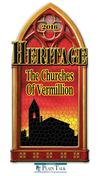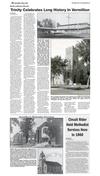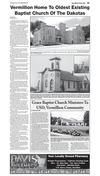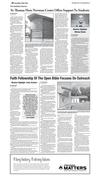6




ROP
6B Vermillion Plain Talk
Heritage 2016, www.plaintalk.net
Influx Of Swedish Immigrants
Leads To New Churches
BY DAVID LIAS
david.lias@plaintalk.net
The appearance of more than
two hundred Swedish families
during the period from 1868 to 1872
not only brought into existence the
most compact settlement within
the state, but also introduced the
Swedish Lutheran Church into Clay
County.
The immigrants located their
new homes east of the Vermillion
River, occupying the greater part of
Garfield and Glenwood townships,
the northern part of Prairie
Center and portions of Pleasant
Valley and Riverside. Herbert S.
Schell, in his book “Clay County:
Chapters Out of the Past,” notes
that the area became known as the
Dalesburg settlement, stretching at
its greatest extent about 15 miles
along the river and eastward for
a distance of six to eight miles.
Like many other ethnic groups,
the Swedes tended to segregate
themselves during the settling
process, thus becoming a closely
knit society. Since so many came
from the province of Dalarna, their
settlement at first was given the
name of Dahlsborg; the spelling,
officially, became Dalesburg in
1869.
The Swedish community was
organized socially and culturally
around the churches established
within its boundaries. The first and
largest of these was the Dalesburg
Lutheran congregation, formally
organized in January 1871 in
accordance with the tenets of the
Augustana Synod. Later in the
year, the Bloomingdale Baptist
society was formed two miles away
-- eventually becoming known as
the Dalesburg Baptist Church. Two
small “free-church” congregations,
representing the Swedish
Mission organization, made their
appearance at Komstad to the
north and in the southwestern part
of Garfield Township.
The first arrivals began to meet
as early as July 1868 in different
PLAIN TALK FILE PHOTO
An ethnic tradition that has played an important part in the history
of the Dalesburg Lutheran congregation has been the annual Midsommar Fest. Its observance was introduced into the community
by its first settlers from Dalarna in 1868. It represents an ancient
festival celebrating the return of summer with its long days -- at the
time of the summer solstice on about June 22.
homes for Sunday worship, singing
Swedish hymns and listening to
readings from the Scriptures as
well as from published sermons.
The first effort to organize a church
society in October 1869 failed
because of sharp disagreement
over church doctrine between
those in support of the traditional
Lutheran Church and those
adhering to more pietistic and
Anabaptist views that had found
wide acceptance throughout the
mother country in opposition to
the old established state church.
A Lutheran congregation
was formed on Jan. 2, 1871 by
the Rev. P. A. Lindahl, an Illinois
missionary who is said to have
walked a distance of about 11 miles
from Vermillion to the Swedish
community in the Dalesburg area.
Holy Communion was observed
and five children baptized at the
meeting. During the preceding
month, he had also organized the
Ahlsborg congregation in nearby
Union County. In the meantime,
the Minnesota Conference of the
Augustana Synod had assumed
responsibility for looking after
the spiritual needs of the Dakota
settlers, sending traveling
ministers into the community for
occasional visitations to preach
the Word and administering the
Sacraments as well as performing
other functions.
The first resident pastor was
the Rev. Carl S. Beckstrom, who
served the congregation from
1871 to 1875. This was followed
by an interval of half a dozen
years when the congregation was
receiving irregular visits from
missionary pastors. In 1880 a call
was extended to the Reverend C.
J. Carlson who was to continue his
pastorate until 1887. This marked
the beginnings of real stability for
the local congregation.
By the time of Pastor Carlon’s
departure, the congregation
included 163 communicants
and 157 children, 75 of the latter
in regular attendance in the
Sunday School organized in 1882.
The congregation during the
period benefited greatly from
the arrival of numerous new
families from Sweden. Among the
many accomplishments during
the Carlson ministry were the
organization of sewing societies
and the establishment of parochial
schools. A Missionary Society,
formed during 1892, became the
first Women’s Missionary Society to
be organized within the Minnesota
Conference.
The departure of the Rev.
Carlson was followed by a
succession of pastorates of fairly
lengthy tenure, an important factor
in the congregation’s growth.
During the 35-year period from
1880 to 1910, the organization
increased from 300 to 425 baptized
members to become the largest
Swedish Lutheran congregation
within South Dakota.
A church structure, made of
cottonwood lumber in 1874 at a
cost of about $425, was the first
Swedish Lutheran church building
in the state. A new edifice was
built in 1896 to replace the earlier
one which had become too small
for the needs of the growing
congregation. A parsonage, built in
1882, was replaced with a new and
larger structure shortly after 1900.
Extensive improvements, made
to the church building during the
early 1920s, included the addition
of a full basement to accommodate
the rapidly increasing social
activities. At the same time, the
original tower was removed and
replaced with a new front. A new
parsonage was built in 1954.
By 1932, English services had
become the rule with preaching
in the Swedish on the first Sunday
of each month. The last usage
of the Scandinavian language
was made during the 1940s in
the form of Sunday afternoon
services. Although the Lutheran
congregation had remained 95
percent Swedish in its ethnic
background as late as 1925, the
ratio had dropped to 80 percent by
1945 at which time 14 percent of
the congregation was of Norwegian
ancestry. Moreover, a number of
Danish extraction had become
members when the Rockfield
Lutheran congregation disbanded
in 1967. Unlike most rural churches
which have suffered declines
during recent years, the Dalesburg
Lutheran congregation experienced
an increase of 32 percent in its
membership during the period
from 1968 to 1978.
An ethnic tradition that has
played an important part in the
history of the Dalesburg Lutheran
congregation has been the annual
Midsommar Fest. Its observance
was introduced into the community
by its first settlers from Dalarna
in 1868. It represents an ancient
festival celebrating the return of
summer with its long days -- at
the time of the summer solstice
on about June 22 -- with outdoor
festivities equalling the observance
of the Christmas holidays in their
gaity. During the community’s early
days the festival, for the greater
part, was a large neighborhood
picnic with a noon public dinner
followed by speeches as well as a
baseball game and interspersed
with performances by a community
chorus, formed in 1874, and the
Dalesburg concert band organized
in 1886. The Midsummer picnics
were directed from the Lutheran
parsonage with its front porch
serving as the stage.
The revival of the community
festival in recent years not only
commemorates the Scandinavian
heritage but also serves to create a
community identity which includes
the Dalesburg Baptist and Komstad
Covenant churches. The program
usually includes a smorgasbord and
a program of Scandinavian culture
with Maypole dancing as well as
music and a softball game. On the
Sunday of the weekend, the community’s three congregations worship
together. The 100th annual Midsommer Fest was held at Dalesburg
Lutheran on June 22, 1979.
Missouri-Synod Lutherans Organize Vermillion Church
BY DAVID LIAS
david.lias@plaintalk.net
A German Lutheran
congregation made its initial
appearance in the county in
1948 when the Missouri Synod effected an organization
in Vermillion. Although many
of the early settlers were of
German heritage, they were
generally identified with the
Reformed and Congregational denominations. This
was especially true of those
of colonial stock.
Still others, residing
mostly in Burbank and Vermillion, as well as Lodi and
Star Prairie areas, were members of the United Brethren
Church -- a denomination
representing an outgrowth
of the Anabaptist Movement that had developed in
Germany during the early
Reformation period.
According to Herbert S.
Schell’s book “Clay County:
Chapters Out of the Past,”
most of the early settlers
of German descent came
from Stephenson County in
northern Illinois, many of
them of colonial origin out of
Pennsylvania.
A Lutheran congregation in Alcester is said to
PHOTO COURTESY OF CLAY COUNTY HISTORICAL SOCIETY
A congregation of the Lutheran Church, Missouri Synod was formed in Vermillion in
1940. The name Concordia was chosen to signify the doctrinal harmony upon which
it was founded. Later on, the church acquired property on the southwest corner of
University and Main streets, where the present brick structure was dedicated on April
19, 1952.
have been the first Missouri
Synod society in South
Dakota, formed in 1875 by a
group of German Lutherans
from northern Iowa. That
distinction has, however,
been generally accorded to
a congregation of GermanRussians formed in 1876 in
Hutchinson County several
miles southwest of Freeman.
The Missouri Synod
continued to grow in membership with main strength
in the "east-river" area
extending from Aberdeen to
Yankton. During the 1920s it
decided to extend its field of
activities to include student
work at South Dakota’s state
educational institutions.
Following an investigation in 1926 by a Yankton
minister, plans were made
for concentrated work with
students of the Lutheran
faith at the university.
Although a pastor was called
in 1928, the operations were
shifted to the institution at
Brookings. In the meantime,
the students identified
with the Synod in Vermillion were urged to attend
services at Yankton where
the congregation agreed to
provide free bus transportation. The plan, however,
proved unsuccessful as did
a subsequent effort to open
a mission station at Vermillion with a young ordained
New Alliance Church
minister in charge of the
student work.
A move was finally made
during the early 1940s to
acquire title to the “Lewis
House” on the corner of
Main and South University
streets and have it serve as
both parsonage and temporary chapel. War conditions
and a shortage of pastors,
however, interfered with the
plan. In the meantime, services were conducted from
time to time by ministers
from Yankton and Centerville
in whatever quarters were
available.
In 1948 the Reverend
Ralph L. Moellering accepted
a call from the synod's South
Dakota district to build up a
local congregation and keep
in contact with university
students. The congregation was formally organized
in September 1948 and a
constitution adopted in
April 1949 at which time the
membership consisted of 10
families and a few students
who were in regular attendance. Nine years later, the
organization consisted of
195 members with about 150
Lutheran students participating in its program.
In 1950 the state district
recommended the replacement of the “Lewis House”
with a combination chapel
and student center building
replete with kitchen, lounges
and recreation room. Construction had advanced sufficiently by December 1952
to hold Christmas services.
A parsonage was added
later. The entire building was
completed by August 1956 at
a total cost of $110,000.
The Rev. Moellering left
the community for a new
position in Chicago, following the dedication of the new
Concordia Lutheran Church
and student center in April
19, 1953. After a short interim
under the Rev. John Hubertz,
the campus pastorate was
held by Cari J. Stapf during
the formative period from
1955 to 1959. Following the
services of the Reverend
J. A. Krueger from 1959 to
1963, a call was extended to
the Rev. Robert Hackler who
was in charge of the program
for a period of 14 years. By
the early 1980s, Concordia
Lutheran had grown in scope
to comprise about 200 confirmed members, including
some 25 university students.
Thank You
Douglas James Rasmussen, in his thesis titled “The First Catholic Church
in Dakota,” notes that “the church, as a microcosm of society, mirrored the
culture in which it existed. As South Dakota entered the 20th century, it
changed ...”
This special Heritage edition celebrates the history of churches in
Vermillion, and the influence they played as settlers went about the
challenging task of taming this plot of prairie near the Missouri River that
we call home.
Our thanks to Wess Pravecek and the Clay County Historical Society,
and the resources they maintain in the Austin-Whittemore House. We’re
also grateful for local pastors who helped supply information and photos
that we are sharing in this special issue.
Much of the information in this special section has been “borrowed,” so
to speak, from others who have done a good job over the years of keeping
a historical record of all aspects of life in the Vermillion community. These
individuals include Rasmussen, Herbert S. Schell, author of “Clay County:
Chapters Out of the Past,” and Thomas R. Thaden, author of “From the
River Valleys to the Rising Bluff – A Pictorial History of Vermillion, South
Dakota.”
The process of compiling information and gathering old photographs
serves as an important reminder of the role that churches will always
play in communities like Vermillion. We urge everyone who reads our
Heritage Edition to take a moment to thank our colleagues who purchased
advertising to make this publication a reality. Their support is greatly
appreciated.
This photo is from the cover of the program for the dedication service of the New Alliance
Church of the Christian and Missionary Alliance, located at the corner of Prospect and
National streets in Vermillion. The church was dedicated June 3, 1956. Pastor of the church
at that time was the Rev. William W. Sibley.
The Staff of the
Vermillion Plain Talk













 Previous Page
Previous Page






